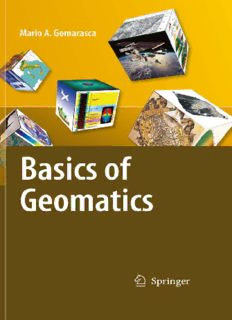Table Of ContentBasics of Geomatics
“This page left intentionally blank.”
Basics of Geomatics
by
Mario A. Gomarasca
NationalResearchCouncilofItaly,Instituteforthe
Electromagnetic SensingoftheEnvironment,
Milano,Italy
123
MarioA.Gomarasca
NationalResearchCouncilofItaly
InstitutefortheElectromagnetic
SensingoftheEnvironment
ViaBassini,15
20133Milano
Italy
[email protected]
ISBN978-1-4020-9013-4 e-ISBN978-1-4020-9014-1
DOI10.1007/978-1-4020-9014-1
SpringerDordrechtHeidelbergLondonNewYork
LibraryofCongressControlNumber:2009926868
This is a translation revised and enlarged of the original work in Italian “Elementi di Geomatica”
publishedbyAssociazioneItalianadiTelerilevamento,©2004.
©SpringerScience+BusinessMediaB.V.2009
Nopartofthisworkmaybereproduced,storedinaretrievalsystem,ortransmittedinanyformorby
anymeans,electronic,mechanical,photocopying,microfilming,recordingorotherwise,withoutwritten
permissionfromthePublisher,withtheexceptionofanymaterialsuppliedspecificallyforthepurpose
ofbeingenteredandexecutedonacomputersystem,forexclusiveusebythepurchaserofthework.
Coverillustration:ImagesbyLucaDiIonno
EnglishtranslationbytheAuthorassistedbySaradeSantisandAndrewLowe
Printedonacid-freepaper
SpringerispartofSpringerScience+BusinessMedia(www.springer.com)
ThisprojectisformysonsIlariaCamilla(Ila)
andJacopoAndrea(Jepus)
“This page left intentionally blank.”
Foreword
Geomatics is a neologism, the use of which is becoming increasingly widespread,
even if it is not still universally accepted. It includes several disciplines and tech-
niques for the study of the Earth’s surface and its environments, and computer
scienceplaysadecisiverole.AmoremeaningfulandappropriateexpressionisGeo-
spatialInformationorGeoInformation.
Geo-spatial Information embeds topography in its more modern forms
(measurements with electronic instrumentation, sophisticated techniques of data
analysis and network compensation, global satellite positioning techniques, laser
scanning,etc.),analyticalanddigitalphotogrammetry,satelliteandairborneremote
sensing,numericalcartography,geographicalinformationsystems,decisionsupport
systems,WebGIS,etc.
These specialized fields are intimately interrelated in terms of both the basic
scienceandtheresultspursued:rigidseparationdoesnotallowustodiscoverseveral
commonaspectsandthefundamentalimportanceassumedinasearchforsolutions
inthecomplexsurveycontext.
The objective pursued by Mario A. Gomarasca, one that is only apparently
modest, is to publish an integrated text on the surveying theme, containing simple
andcomprehensibleconceptsrelevanttoexpertsinGeo-spatialInformationand/or
specificallyinoneofthedisciplinesthatcomposeit.Atthesametime,thebookis
rigorousandsynthetic,describingwithprecisionthemaininstrumentsandmethods
connectedtothemultipletechniquesavailabletoday.
Thebookisaddressednottosuper-specialists,buttoawidergroupoftechnicians
andstudentswhomayuseGeo-spatialInformationintheirwork,orwhoalreadyuse
itaspartoftheirdailyprofessionalactivityorstudy.Morespecificallythebooktar-
gets at land managers, operating in natural or anthropic environments (engineers,
geologists, agronomists, architects, urban planners, operating in the field of archi-
tectural assets and environment, technicians at land-surveying agencies, etc.), and
studentsatbothfirstandmasterlevels,moreandmoreofwhomarefacingthemes
inwhichthedisciplinesofthesurveyplayadeterminingrole.
Mario A. Gomarasca is a researcher at the National Research Council of Italy,
expertinremotesensingappliedtoagricultureandenvironment,andmorerecently,
for many years (1997–2003), he has held the prestigious and engaging position
of president of ASITA (Federation of the Scientific Associations for Land and
vii
viii Foreword
Environment Information). In this role, which he performs with enthusiasm and
great efficiency, he has become a privileged observer of the topics of Geo-spatial
Information, since he coordinates the National Conferences, at which some hun-
dredsofscientificpapersarepresentedannually.
The absolute specialist in a single field will not find profound or very specific
innovativeelementsinhis/herparticularcompetence,butthesamespecialistwillbe
abletoaddelementsfromadjacent,interrelateddisciplinesandtechniques.
Thereaders,whetheruniversitystudent,professional,technicianorlaystudent,
willfindreadyaccesstothefundamentalconceptsandup-to-dateinformationonthe
stateoftheart,givingthemawiderfieldofviewofthecomplex,multidisciplinary
problemsrelatedtolandsurveyingandtheenvironment,especiallyinlandplanning.
Thisobjective,whichImustwarnthereaderisdecidedlyotherthanmodest,is
totallyachievedinthisbook.Toboth,thebookanditsauthorMarioA.Gomarasca,
Iwishthebestandallthegoodfortunetheydeserve.
Turin,Italy SergioDequal
Author’s Preface
WhenIdecidedtorevisitmyfirstbook‘GISandRemoteSensingfortheManage-
mentoftheAgriculturalandEnvironmentResources’(publishedbyAITin1997)
at the end of November 1999, while waiting for a flight to Niamey, Niger, at the
ParisCharlesDeGaulleairport,withmyunforgettablecolleagueandfriendEugenio
Zilioli,Ihadinmindtoonlyupdatethetextforthesecondreprint.
Whilereadingandre-reading,withthegrowingknowledgethatinthemeantime
wasintegratingitselfinASITA,theItalianFederationoftheScientificAssociations
fortheLandandEnvironmentInformation,ofwhichIhadbeenelectedandserving
as President since 1998, and with the rising interests of the profession, grew the
idea to broaden the content and to develop a more ambitious project involving an
interactiveapproachtosomeofthemaintopicsofGeo-spatialInformation.
Afteryearsofreading,research,study,complexbibliographicalconsultationand
selection,alongwiththoroughandsometimecriticalreviewsfrommanyexperts,the
Italianversionofthebook(2004)introducedapanoramatotheneophyteandcom-
pletedtheframeworkforthosewhoalreadyworkinthefield,inordertointegrate
theknowledgeofGeo-spatialInformation.
ConsideringthelargesuccessofthebookinItalyandtheworldwideinterestand
development of geomatics, I decided to undertake the challenge in preparing the
Englishrevisedandenlargedversionofthatbook.
Thisbookintroducesvariousdisciplinesandtechniquesandisofferedasareview
ofthesubjecttostimulatethereader’sinterests.Mathematicaldemonstrationsand
deeperexplanationshavebeenomitted,butanaccurateselectedbibliographyispro-
vided,chapterbychapter,toassistinfindingspecificreferences.
Geo-spatial Information is still a relatively new discipline with fuzzy contours,
opentomanyinterpretations;addingmyownpersonalpointofview,whichcould
generateapprovalandcriticism,opening,Ihope,ascientificandprofessionalcon-
structivedebate.
The book does not lay claim to answering multiple issues that Geomatics
includes, but it proposes an interdisciplinary integration in order to contribute to
facetheproblemsprovidedbythiscomplexworld.
Thenecessityofdefiningtechnicaltermsoccursinmanypassagesofthisbook;
I tried to impose an order on the labyrinth of definitions and acronyms that are
often used in a general way. At this stage, with no existing universally recognized
ontologicaldictionaryandthesaurus,Ihaveselectedanomenclaturewiththemore
ix
Description:This volume presents a comprehensive and complete treatment. In a systematic way the complex topics and techniques are covered that can be assembled under Geospatial Information namely, Geodesy, Cartography, Photogrammetry, Remote Sensing, Informatics, Acquisition Systems, Global Positioning Systems

